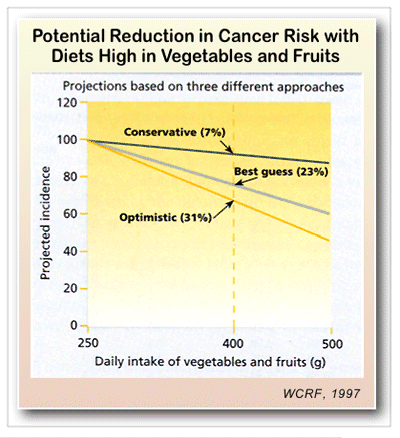
Diet and Cancer: What Have We Learned?
by Laurence Kolonel, M.D., Ph.D., Deputy Director, Cancer Research Center of Hawaii, Honolulu

In the mid-1970s, the U.S. National Cancer Institute initiated a Diet and Cancer Program to support investigations in this largely unexplored area. Over the last 25 years, scientific reports on nutrition and cancer relationships have appeared with increasing frequency. What has this body of research revealed?
An Historical Perspective
Many of the earliest studies in the field of diet and cancer were ecologic, examining correlations between cancer rates and cross-sectional dietary exposures, generally based on dietary surveys or national food consumption data and corresponding incidence or mortality rates. Among the earliest was a study by Armstrong and Doll in 1975, which suggested that higher consumption of meat might predispose to colon cancer and that higher intake of dietary fat might predispose to breast cancer.
Subsequent studies emphasized the case-control approach, in which patients with particular types of cancer and suitably matched controls were interviewed about their diets prior to the onset of the disease. Because dietary recall can be biased (inadvertent overestimation or underestimation by cases relative to controls), many investigators initiated large prospective cohorts, such as the renowned Nurses Health Study at Harvard University and the Cancer Prevention Study of the American Cancer Society, as well as the more recent Multiethnic Cohort Study of Diet and Cancer, and the European Prospective Investigation into Cancer and Nutrition (EPIC). While much more costly, these studies obtain dietary information from subjects prior to the onset of illness, thereby obviating the potential recall bias of case-control studies.
Increasingly frequent reports from cohort studies since the 1990s have been crucial to establishing most of the diet-cancer relationships noted below. Although intervention studies (randomized control trials) are considered the ultimate means to explore the relationship of an exposure like diet to cancer, such investigations also have limitations and are rare, due to their enormous cost, difficulty to implement, and the impracticality of testing more than a single exposure level in one study.
Can Diet Increase Cancer Risk?
Many early case-control studies suggested a role of dietary fat, especially saturated fat, in the etiology of cancers at several sites, especially the breast, prostate and colorectum (large bowel). Because the major sources of saturated fat in most Western diets are meat (notably red meat) and whole dairy products, these food groups in particular were implicated. However, subsequent cohort studies have been less supportive of this association. Furthermore, a 2006 report from an intervention trial, the Women’s Health Initiative, failed to show a reduced risk of breast or colorectal cancer in women who followed a low-fat diet (though the women only maintained an average fat intake of 29 percent of calories, which is not particularly low). Thus, the role of dietary fat per se in these cancers remains unclear. Nevertheless, there is a strong biologic rationale for such an effect, and supportive data from animal studies, so the hypothesis remains viable.
Other dietary constituents that may increase the risk of cancer include the heterocyclic amines and polycyclic hydrocarbons formed in meats cooked at high temperature or charcoal-broiled, and nitrosamines that can be formed from foods preserved with nitrates or nitrites (such as processed meats). An established carcinogen for humans is aflatoxin, a substance produced by molds that can contaminate improperly stored ground nuts, legumes and grains.
Obesity, which reflects an energy imbalance in the body, is clearly associated with several cancers, including those of the colon, endometrium, breast (in postmenopausal women), lower esophagus, kidney and gallbladder. And obesity is a growing global problem. Today, in the United States alone, more than 60 percent of adults are estimated to be overweight, with half of them classified as obese. And the developing world has not been spared: Obesity rates in India are now estimated at 15 percent.
[see full article...]